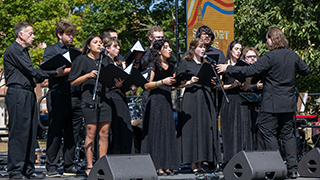YouTube Influencers Steal "Idols" – Professors Collaborate on Article - Seton Hall University
Thursday, April 7, 2022

On October 21, 2019 two men stole a set of small statues on display at the Church of St. Mary in Transpontina, Italy. Depicting nude kneeling pregnant women, the statues were gifts brought by South American Catholics for Pope Francis' Pan-Amazonian Synod. They had been blessed in a Vatican garden ceremony, but critics quickly associated them with an Incan goddess named Pachamama, a non-Christian deity. The thieves brought the statues to the Ponte Sant'Angelo bridge and cast them into the Tiber River. The series of actions was filmed, edited and anonymously uploaded to YouTube under the title "Pachamama idols thrown in the Tiber River!".
Radwan and Giffone seek to interpret this "iconoclepsis" (image-stealing) video through communication frames described by Plato and the Bible, and to assess protest rhetoric attempting Church reform in light of their philosophical and spiritual teaching. The two decided to collaborate due to an intersection in research interests. When asked what makes religious idols relevant today, Giffone stated, "With the constant evolution of technology, there are new dimensions to the old questions of censorship, religion, and reform. The Pachamama incident is just one example of how these questions lead to action."
Radwan added that most contemporary media theories use secular frames that fail to explain the controversial power of religious art. "Modernists tend to dismiss religion as myth, and postmodernists tend to treat religious rhetors as people striving for social power instead of a relationship with God," he said. "Media scholars should look to spiritually oriented sources like Plato and the Bible to understand religious communication and symbolism."
One of the iconoclepts, Alexander Tschugguel, later took responsibility and used associated publicity to launch the St. Boniface Institute. These influencers seek to "fight against" idolatry in the Church, citing a perceived decline in the Church's stance against paganism and globalism. This criticism of Pope Francis' leadership matches other "discourses of agitation and dissent" among fringe Catholic groups. Radwan and Giffone argue that these groups appear "unlikely to advance reform." When reached for comment on this conclusion, Giffone explained that meaningful reform can only work through the Catholic Church's leadership hierarchy. "Reform through antagonizing the hierarchy will be unsuccessful," he stated. "To achieve reform in this way is essentially a 'Protestant' act; there is a clear choice before them, to accept the authority of hierarchy or break away from it and become Protestant."
Whether the video demonstrates sincere concern, xenophobia and racism, or semi-viral influence, videoing and posting crimes appears misguided. The article concludes that the social media protest misunderstands Catholic approaches to indigenous art and community growth, including reform. While social media are too often used to spread misinformation and division, they can also be used to share eudaimonia, or spiritual well-being. Radwan explained the contrast between aggressive YouTubers and Christian leadership. "Pope Francis is a wonderful model of how to respond to social media critics with patience and care. Rather than get angry or seek legal redress, he reminds us that communication is Christian when it advances love of God and neighbor. In his new encyclical Francis teaches us that '[S]ome believers think that it [spirituality] consists in the imposition of their own ideologies upon everyone else, or in a violent defense of the truth, or in impressive demonstrations of strength. All of us, as believers, need to recognize that love takes first place: love must never be put at risk, and the greatest danger lies in failing to love (cf. 1 Cor 13:1-13).'" (Fratelli Tutti, 92)
About the Institute for Communication and Religion
Launched in Fall 2017, the Institute for Communication and Religion within the College of Communication and the Arts provides a nexus for ongoing scholarly exploration of communication topics critically
important to religion and society. Guided by the spirit of ecumenical and interreligious
cooperation, the Institute seeks to engage in public dialogue and debate, promote
academic inquiry and support the religious dimension of creativity — all while upholding
the values of servant leadership, curricular innovation and intellectual excellence.
For more information click here to visit the Institute for Communication and Religion.
Categories: Arts and Culture, Faith and Service






